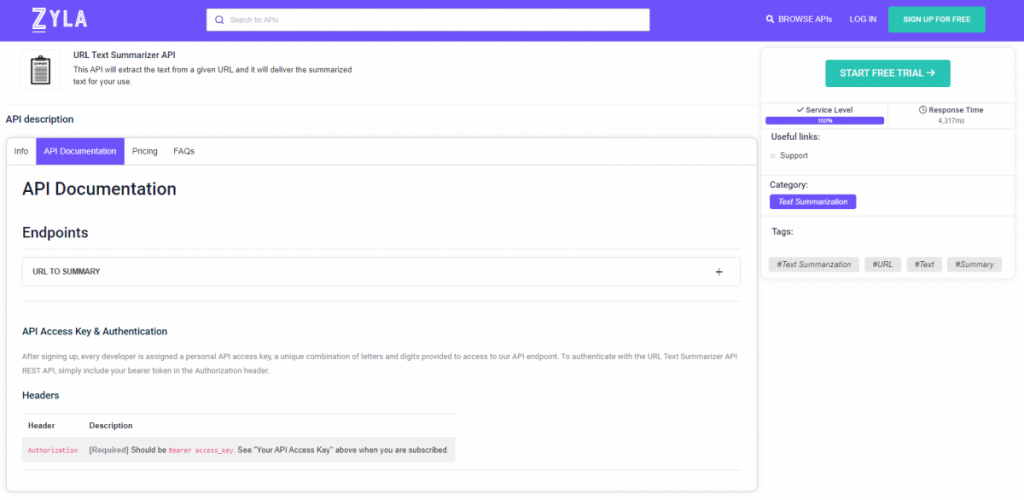Navigating through a vast sea of web content can be overwhelming. Lengthy articles, research papers, and blog posts often make it challenging for readers to access essential information efficiently. However, with Text Summarizers, users can now simplify information overload. This powerful technology offers a transformative solution by converting web URLs into concise summaries, providing users with a quick overview of the content. In this article, we will introduce you to URL Text Summarizer API technology and explore how it simplifies the process of information consumption.

Invest In A URL Text Summarizer API
URL Text Summarizer APIs stand as powerful solutions for simplifying information overload in the digital age. Its ability to provide concise summaries from web URLs empowers users to access valuable insights efficiently. Whether for researchers, content curators, business professionals, or students, these APIs streamline the process of information consumption, making it more effective and convenient. By embracing the URL Text Summarizer API, users can navigate through the vast sea of web content with ease, extracting essential knowledge and staying well-informed in today’s information-rich world.
A URL Text Summarizer API is a cutting-edge tool designed to streamline information consumption. By analyzing the text within a given URL, these APIs deliver succinct summaries, allowing users to grasp the main points without wading through lengthy content.
The API serves as a useful skim reader for users looking for quick insights. It saves important time and effort by distilling the main points and overarching concepts into a concise summary. Additionally, the API’s capacity to summarize research papers, academic publications, and reports can be very useful to academics and students. Users are better able to access knowledge thanks to the accelerated research and learning processes.
Content curators and creators can enhance their curation process by leveraging the API. By summarizing content from various sources, curators can identify relevant material for their audiences, ensuring curated selections that offer maximum value. In the fast-paced business world, staying informed is essential for making data-driven decisions. A URL Text Summarizer API enables professionals to quickly analyze market trends, competitor strategies, and industry reports, facilitating well-informed choices.
With the API’s concise summaries, users can efficiently select articles to explore further, simplifying the process of content consumption amidst information overload. URL Text Summarizer APIs offer a user-friendly integration process, making it accessible to developers with varying levels of expertise. Its seamless integration ensures a hassle-free experience, enabling users to leverage its benefits effortlessly.
Check URL Text Summarizer API
The URL Text Summarizer API is a powerful tool that can be used to quickly and easily summarize text from websites. It is backed by machine learning technology, which ensures that the summaries are accurate and informative.
The API is easy to use. Simply pass the URL of the website you want to summarize, and the API will return a summarized text that is tailored to the specific needs of the user. The summaries are concise and accurate, and they capture the most important information from the original text.

This makes the API ideal for a variety of purposes, such as:
- Getting the gist of a website without having to read the entire thing.
- Summarizing text for students or employees.
- Creating marketing materials that are easy to read and understand.
- Extracting key information from websites for research purposes.
The URL Text Summarizer API is a valuable tool for anyone who needs to summarize text from websites. It is easy to use, accurate, and affordable.
Here is an example of how the URL Text Summarizer API can be used:
A business could use the API to summarize its website for potential customers. This would allow them to quickly and easily create a concise and informative summary of their website, which would make it easier for potential customers to understand what the business does and why they should choose them.
How To Use This API?
- First, go to URL Text Summarizer API and click the “START FREE TRIAL” button.
- You will be able to access the API once you have registered with the Zyla API Hub.
- Go to the API endpoint “URL to Summarizer” and insert your URL.
- Finally, click the “test endpoint” button. This will give you a summarized text for your use.
For example, if we introduce the URL “https://en.wikipedia.org/wiki/2023_Tour_de_France_Femmes“, the API will give us a response similar to this:
[{"marked_text":"The 2023 Tour de France Femmes (officially Tour de France Femmes avec Zwift) was the second edition of the Tour de France Femmes.The race took place from 23 to 30 July 2023, and was the 21st race in the 2023 UCI Women's World Tour calendar.The race was organised by the Amaury Sport Organisation (ASO), which also organises the men's Tour de France.The race was won by Demi Vollering of SD Worx, beating her rival Annemiek van Vleuten (Movistar Team) with a dominant stage win on the Col du Tourmalet.Second place went to Vollering's teammate Lotte Kopecky, who wore the yellow jersey for six stages after winning the first stage.The podium was rounded out by Katarzyna Niewiadoma of Canyon\u2013SRAM for the second year in a row.In the race's other classifications, Kopecky won the points classification.Apart from finishing third in the general classification (GC), Niewiadoma also took the polka-dot jersey as winner of the Queen of the Mountains (QoM) classification.C\u00e9drine Kerbaol of Ceratizit\u2013WNT Pro Cycling took the white jersey as the winner of the young riders classification, which was awarded to the best-placed rider under the age of 23.SD Worx won the team classification as the team with the lowest aggregate time among their three best-placed riders.Yara Kastelijn took the super-combativity award to add to her win on stage 4.Overall, the race was highly praised by the public, media, teams and riders \u2013 with large crowds and high TV viewership.Race director Marion Rousse stated that the 2023 edition \"was the year of confirmation: we had to prove that the first edition was not just curiosity\".22 teams participated in the race.[1] Each team had seven riders, one more than the 2022 edition.[2] The teams were announced on 14 April 2023.[1] All 15 UCI Women's WorldTeams were automatically invited.[3] They were joined by seven UCI Women's Continental Teams \u2013 the two best 2022 UCI Women's Continental Teams (Ceratizit\u2013WNT Pro Cycling and Lifeplus\u2013Wahoo) received an automatic invitation, and the other five teams were selected by Amaury Sport Organisation (ASO), the organisers of the Tour.[3] 154 riders from 27 nationalities started the race, the largest percentage of whom were Dutch (19% of the peloton).[4]\n\nIn October 2022, the route was announced by race director Marion Rousse.[5] It comprised eight consecutive days of racing, covering a total of 960.5 kilometres (596.8 mi).The race started in Clermont-Ferrand on the same day that the men's tour finished in Paris, before heading south across the Massif Central (including the longest, stage 4) towards the Pyrenees.The penultimate stage was the queen stage of the Tour, with a summit finish at the Col du Tourmalet in the Pyrenees at an elevation of 2,115 m (6,939 ft).The final stage was an individual time trial in Pau, using a similar course to the 2019 edition of La Course by Le Tour de France.[5][6] 2022 winner Annemiek van Vleuten called the route \"an upgrade\", with other riders welcoming the inclusion of bigger climbs and a time trial.[7][8]\n\nAs with the 2022 edition, the route required a waiver from the Union Cycliste Internationale, as Women's WorldTour races have a maximum stage length of 160 kilometres (99 mi) and a maximum race length of six days.[9]\n\nAhead of the race, Annemiek van Vleuten and Demi Vollering were considered pre-race favourites for the general classification (GC), following Van Vleuten's wins earlier in the season at La Vuelta Femenina and Giro Donne, and Vollering's second places at La Vuelta Femenina and the 2022 Tour de France Femmes.[11][12][13] Other contenders tipped for the general classification (GC) included Elisa Longo Borghini, Juliette Labous, Ashleigh Moolman Pasio and Veronica Ewers.[11][12][13]\n\nLorena Wiebes, Charlotte Kool, and Silvia Persico were considered favourites for the points classification, with Van Vleuten and Vollering tipped for the mountains classification.[11][12][13] Eleonora Gasparrini, C\u00e9drine Kerbaol and Alice Towers were considered favourites for the young rider classification,[12] and SD Worx were considered favourites for the team classification.[14]\n\nOverall, the field of 154 riders was described as \"stacked\",[15] with the top 13 finishers from the 2022 edition all taking part.[16] Media coverage prior to the event was very positive, with anticipation of the summit finish at the Col du Tourmalet and the time trial in Pau.[13][17] The start in Clermont-Ferrand was also welcomed,[18] with Rouleur stating it \"breaks the shackles that tie it to the men\u2019s race\".[19] The prize fund remained at \u20ac250,000 (compared to \u20ac2.3 million for the men's tour), with \u20ac50,000 for the winner of the general classification - making it one of the richest races in women's cycling.[20][21]\n\nTaking place earlier on the same day of the final stage of the men's Tour, stage 1 of the race looped around Clermont-Ferrand.[22] On the final climb, Lotte Kopecky (SD Worx) attacked, accelerating further in the final 5 km (3.1 mi).She took a solo stage win by 41 seconds, taking the first maillot jaune (yellow jersey) of the race, as well as the points classification and the Queen of the Mountains (QoM) classification.C\u00e9drine Kerbaol (Ceratizit\u2013WNT Pro Cycling) took the lead in the young rider classification.[23]\n\nThe second stage took the riders south from Clermont-Ferrand to Mauriac, over a hilly course with six categorised climbs.[22] The second half of the stage was affected by heavy rain, with several riders crashing in the last 20 km (12 mi), including Eva van Agt (Jumbo\u2013Visma) who was taken to hospital with a concussion.[24] In the uphill sprint towards the finish line, Demi Vollering (SD Worx) led out her teammate Kopecky, however Liane Lippert (Movistar Team) overtook Kopecky in the final 100 metres to win the stage.After the stage, Kopecky realised she had a slow puncture that had dampened her sprint.Kopecky retained the yellow jersey of the general classification (GC), with Yara Kastelijn (Fenix\u2013Deceuninck) taking the lead of the classification.[25]\n\nStage 3 to Montignac-Lascaux took the riders westwards over a flat course, with a bunch sprint expected.[22] Julie Van de Velde (Fenix\u2013Deceuninck) escaped with around 60 km (37 mi) of the stage remaining.Taking points over the final two climbs, she took the lead of the mountains classification while building up a lead of around a minute.In the final sprint, Van de Velde was caught by the peloton with 300 metres to go, with Lorena Wiebes (SD Worx) winning the bunch sprint for the stage.[26]\n\nThe fourth stage to Rodez was a hilly course, with five categorised climbs, another climb with bonus seconds at the top and a steep finish into Rodez.[22] It was also the longest stage of the race at 177.1 km (110.0 mi) in length.[22] A breakaway gained 10 minutes over the peloton, before Yara Kastelijn attacked from the break on the final climb.Behind her, rivals Demi Vollering (SD Worx) and Annemiek Van Vleuten (Movistar Team) attacked each other, overtaking remains of the breakaway approaching the finish.Kastelijn's solo attack won her the stage by 1' 11\", her first major stage win in the UCI Women's World Tour.Behind Kastelijn, Vollering attacked in the steep final kilometre to take second place on , eight seconds ahead of her main rival Van Vleuten thanks to six bonus seconds at the finish line.Kopecky retained her yellow jersey of the , with Anouska Koster (Jumbo\u2013Visma) talking the polka dot jersey of the classification thanks to the points collected while in the breakaway.[27]\n\nStage 5 to Albi took the riders south over a flat course, heading towards the Pyrenees.[22] Prior to the start, stage 3 winner Wiebes withdrew due to illness.[24] Kastelijn took the points over the first two climbs, taking the lead in the mountains classification.Ricarda Bauernfeind (Canyon\u2013SRAM), an experienced time trialist, attacked from the peloton, eventually building up a lead of around 1' 30\".The peloton gave chase, however the gap did not fall fast enough to catch her.In the closing kilometres, Lippert and Marlen Reusser (SD Worx) attempted to catch her.Bauernfeind was too strong, and crossed the finish line 22 seconds ahead of the pair.[28] During the stage, Vollering suffered a puncture, before drafting her team car to get back to the main bunch, drawing the ire of commissaires.She was subsequently penalised 20 seconds in the general classification, dropping her to seventh place in the , 12 seconds behind her rival Van Vleuten.[29] The following day, SD Worx directeur sportif Danny Stam was removed from the race due to \"inappropriate comments\" made to the commissaires, as well as his \"dangerous overtaking ... of cars and riders\" while Vollering was drafting his car.[30]\n\nStage 6 to Blagnac was the final chance for sprinters to win, given the parcours of the remaining stages.A breakaway including Emma Norsgaard (Movistar Team) was formed with around 70 km (43 mi) to go, establishing a two minute lead.[31][32] During the stage, contender Veronica Ewers (EF Education\u2013Tibco\u2013SVB) crashed heavily.She finished the stage, albeit in pain - it later transpired that Ewers had a broken collarbone and would not start stage 7.[33] In the closing kilometres of the stage, the gap to the breakaway steadily fell as the sprinters teams gave chase.In the final 2 km (1.2 mi), a tight chicane over the Toulouse tramway caused a small crash, distracting the peloton and delaying some riders as they gave chase.[31][32] With 600 metres to the finish, Norsgaard launched an attack, as the gap collapsed behind her.Norsgaard held on to win the stage by a second.Want to learn more? Read Simplify Research With A URL To Text Converter API: From Articles To Actionable Insights

